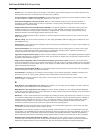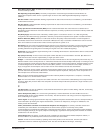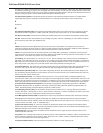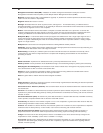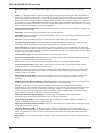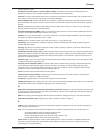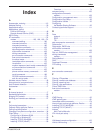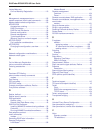
Glossary
RF300E/RF310E 195
uses an external T1 CSU.
Transmission Control Protocol / Internet Program (TCP/IP): A multi-layer set of protocols developed by the US
Department of Defense to link dissimilar computers across dissimilar and unreliable LANs.
Terminal: The screen and keyboard device used in a mainframe environment for interactive data entry. Terminals have no
“box”, which is to say they have no file storage or processing capabilities.
Terminal Adapter (TA): An ISDN DTE device for connecting a non-ISDN terminal device to the ISDN network. Similar to a
protocol converter or an interface converter, a TA connects a non-ISDN device between the R and S interfaces. Typically a
PC card.
Tie line: A dedicated circuit linking two points without having to dial a phone number (i.e., the line may be accessed by
lifting the telephone handset or by pushing a button).
Time-Division Multiplexing (TDM): Division of a transmission facility into two or more channels by allotting the common
channel to several different information channels, one at a time.
Time Slot: One of 24 channels within a T1 line. Each channel has a 64K bps maximum bandwidth. “Time slot” implies the
time division multiplexing organization of the T1 signal.
Toll Call: A call to a location outside of your local service area (i.e., a long distance call).
Tone dialing: One of two methods of dialing a telephone, usually associated with Touch-Tone® (push button) phones.
Compare with pulse dialing.
Topology: Physical layout of network components (cables, stations, gateways, and hubs). Three basic interconnection
topologies are star, ring, and bus networks.
Transmission Control Protocol (TCP): A communications protocol used in Internet and in any network that follows the US
Department of Defense standards for internetwork protocol. TCP provides a reliable host-to-host protocol between hosts in
packet-switched communications networks and in interconnected systems of such networks. It assumes that the Internet
protocol is the underlying protocol.
Transport Layer: Layer 4 of the Open Systems Interconnection (OSI) model; provides reliable, end-to-end delivery of data,
and detects transmission sequential errors.
Transport Protocol Data Unit (TPDU): A transport header, which is added to every message, contains destination and
source addressing information that allows the end-to-end routing of messages in multi-layer NAC networks of high
complexity. They are automatically added to messages as they enter the network and can be stripped off before being
passed to the host or another device that does not support TPDU’s.
Trunk: Transmission links that interconnect switching offices.
TSR (terminate and stay resident): A software program that remains active and in memory after its user interface is
closed. Similar to a daemon in UNIX environments.
Tunneling: Encapsulation data in an IP packet for transport across the Internet.
Twisted pair wiring: A type of cabling with one or more pairs of insulated wires wrapped around each other. An inexpensive
wiring method used for LAN and telephone applications, also called UTP wiring.
U
UART (Universal Asynchronous Receiver/Transmitter) (pronounced “you art”): A chip that transmits and receives data
on the serial port. It converts bytes into serial bits for transmission, and vice versa, and generates and strips the start and
stop bits appended to each character.
UNIX: An operating system developed by Bell Laboratories that features multiprogramming in a muti-user environment.
Unshielded Twisted Pair (UTP): Telephone-type wiring. Tansmission media for 10Base-T.
V
V.25bis: An ITU-T standard for synchronous communications between a mainframe or host and a modem using HDLC or
other character-oriented protocol.
V.54: The ITU-T standard for local and remote loopback tests in modems, DCEs and DTEs. The four basic tests are:
• local digital loopback (tests DTE send and receive circuits),
• local analog loopback (tests local modem operation),
• remote analog loopback (tests comm link to the remote modem), and
• remote digital loopback (tests remote modem operation).
Virtual Circuit: A logical connection. Used in packet switching wherin a logical connection is established between two
devices at the start of transmission. All information packets follow the same route and arrive in sequence (but do not
necessarily carry a complete address).



